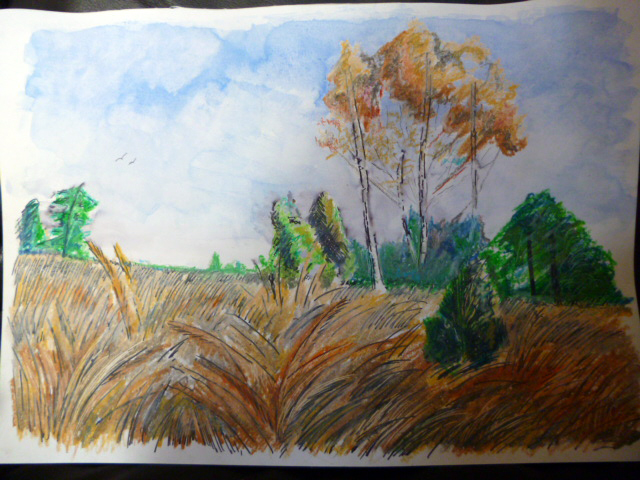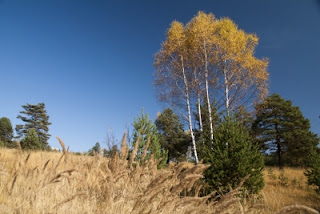Study of several trees P. 100
For my study of several trees, I decided to use Oil Pastel as an alternative to watercolour and yet, being wintertime, I wanted to draw trees with a fair amount of foliage. I chose to use a royalty free image that captured the type of scene I wanted to paint, especially with the foreground grass quite prominent..
I was having a bit of difficulty blending the darker tones with Oil Pastel as it so different to watercolour which I am more familiar with, so knowing that the Oil Pastel lacked transparency, I thought of laying down darker tones which a black marker first, then apply colour later.
I started with lighter oil pastels then gradually built up the colour throughout the picture, adding layers of brown to the foreground grass. I have also found myself trying to be too detailed with oil pastel and it turns out messy so for the trees, I basically blurred my eyes to just generalize what colours were there. After applying my yellows, orange and browns, I moved on to the green foliage.

I am quite pleased with the completed piece considering this was a bit of an experiment on how to apply darker shade. For the more distant tress, I added some cool blues to the trees. I wished I had been more delicate with the trunks on some of the trees, using broken lines which work really well on the tall trees, but I was unsure how much coverage the oil pastels would give over the black ink. For the sky, I chose the subtle approach of using watercolour. I believe it has simplified the picture more especially in the formation of clouds. The added advantage being that I could practically go over the trees and not around them as oil in the pastel worked as the perfect waterproof barrier.
 |
| Royalty Free Image |
 |
| My photo took in early autumn 2012 |
I wanted to tackle this picture in the same way as I did in the one above, but with less black felt tip and only use Oil Pastel as colour. I also decided to try and mix oil pastel on the page more to see how it would blend as I knew it would be impossible to try and recreate all the leaves on the path.
I started in the same way as the previous painting and filled in the dark tones first before applying colour. Again, I blurred my eyes over the photo and tried to apply the oil pastel in this way.
I do not think the completed piece is as well done as the previous trees oil painting, and looks messy in places. Funny enough, I find the picture looks better from distance and the scratches on the path add much needed perspective. I feel that I am still getting to grips with Oil Pastels and perhaps this picture was a bit too big for me but I also think I am adding to my skills and learning about other mediums that I would never thought of trying.
Check and Log
- How many different types of trees have you drawn?
Obviously, with it being in the middle of winter, in terms of doing still life, a lot of greenery is currently absent but it has helped that I planned ahead and did some preliminary work, especially during autumn time when the colours are bright and rich. I have used winter to my advantage and been able to study branch structure from still life while getting to use autumn colours from photographs I have taken. I think I have done well in getting a number of different types of trees in my study, especially with colour and texture and tried not to do too many pieces of all the same type.
- What techniques did you use to distinguish each type?
I have used charcoal and graphite for sketching the structure of branches and tried to use delicate shading to convey shadows and the perspective of branches coming towards the viewer. At the other end of the scale, I have approached other trees in a far more expressive way, using watercolour wet on wet, Ink on wet and Oil Pastel. With certain trees, I found that working more quickly and spontaneous was better in capturing the natural growth of tree, and in the case of watercolour on wet, I tilted the paper to let the watery paint naturally drip in the desired direction.
- What did you do to convey the mass of foliage?
I guess in the case of sketching, a loose zig zag cross over mark created good foliage texture without the impossible task of trying to draw each leaf and it is more of a case of suggesting the overall shade of the foliage mass. In my pieces with colour medium, I tried to blur what I was looking at and to see where light and dark tones were placed within the shape. In terms of watercolour, a Fan Brush can help greatly in creating the overlapping layers of foliage and with oil pastel, the direction of the strokes helped to show which way the foliage was growing. Overall I tried to not to be too rigid with doing foliage as it looked very artificial.
- How did you handle light on the trees? Was it successful?
With my individual sketch of a tree, I used a graphite pencil for my study, and I created light by leaving parts of the branches with just the white of the paper then shaded darker around it, and in terms of highlighting the finer branches, I put down a layer of smudged graphite then used an eraser to suggest the lighter branches. With Oil Pastel, I used tonal colours to suggest where light was hitting as well as leaving gaps in the foliage through which the background sky could poke through.
- Did you manage to select and simplify? Look at your drawings and make notes on how you did this, and what could you do better?
In terms of what to draw in still life, I would use a viewfinder or camera just to frame the subject to see how well the piece worked which helped in cutting off the edges, so to speak but with my sketch of an individual tree, I chose to completely remove the background as part of the sketch as with the amount of finer branches that I planned to put in using the eraser, it was likely that they would not show up that well with the background, and looking at the sketch, I think this was the right choice. As mentioned with the autumn oil pastel, I did deliberately try to not paint the fallen leaves as it would of been difficult. I do think perhaps I went a bit too minimal and made the piece almost abstract, especially along the path area. In contrast, with the painting of the royalty free image, I actually added clouds and birds just to give a bit of interest to the blue sky.

















































